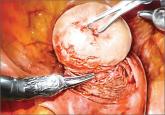News for Your Practice
The robot is broadly accessible less than 10 years after its introduction to gynecologic surgery
More than three-fourths of reproductive and gynecologic surgeons have access, a 2012 survey found
Dr. Truong is Fellow in Minimally Invasive Gynecologic Surgery, Columbia University Medical Center, New York, New York. Dr. Advincula is Professor and Vice Chair, Women’s Health, and Chief, Gynecology, Department of Obstetrics and Gynecology, Columbia University Medical Center. Dr. Advincula also serves on the OBG Management Board of Editors.
Dr. Truong reports no financial disclosures relevant to this article. Dr. Advincula reports being a consultant to Blue Endo, Cooper Surgical, Intuitive Surgical, and Surgiquest and receiving royalties from Cooper Surgical.

This striking educational video kicks off an exclusive surgical tips and techniques series from Arnold Advincula, MD
We present this video with the objective of demonstrating a hysterectomy performed using the robotic single-site approach in juxtaposition with a robotic multiport hysterectomy. In the video, and briefly here, we review the benefits, disadvantages, and challenges of robotic single-site hysterectomy.
The advantages of single-site robotic hysterectomy include:
The disadvantages of single-site robotic hysterectomy include:
Related articles:
The robot is broadly accessible less than 10 years after its introduction to gynecologic surgery. Janelle Yates (News for your Practice; December 2013)
The robot is gaining ground in gynecologic surgery. Should you be using it? Arnold P. Advincula MD; Cheryl B. Iglesia MD; Rosanne M. Kho MD; Jamal Mourad, DO; Marie Fidela R. Paraiso, MD; Jason D. Wright, MD (Roundtable; April 2013)
Identify your learning curve for robotic hysterectomy. Joshua L Woelk, MD, MS, and John B. Gebhart, MD, MS (Guest Editorial; April 2013)
In general, each step of the single-port procedure has been found to be equivalent in time to a multiport approach to robotic-assisted hysterectomy—except for the step of vaginal cuff closure. Since the initial experience, aside from overcoming the learning curve of a new surgical approach, various techniques have been modified in order to surmount this challenge, such as closing the vaginal cuff vertically, using a cutting needle versus a tapered needle, addition of a “plus one” wristed multiport robotic arm, or replacing the single-site robotic needle driver with a multiport 5-mm needle driver.
Nevertheless, widespread adoption of single-site robotic gynecologic surgery still requires further technological improvements, and further research and experience is needed to determine its role, benefits, and applications in gynecologic surgery.
--Dr. Arnold Advincula, AAGL 2014 Scientific Program Chair
WE WANT TO HEAR FROM YOU!Share your thoughts on this article. Send your Letter to the Editor to: rbarbieri@frontlinemedcom.com
More than three-fourths of reproductive and gynecologic surgeons have access, a 2012 survey found
Researchers from Johns Hopkins find clear-cut evidence that a significant proportion of robot-related complications go unreported

With robotic assistance, a surgeon can reduce blood loss, shorten hospitalization, and ease laparoscopic suturing and knot-tying—but myomectomy is...
A ballpark idea of the learning curve for this procedure can enhance patient outcomes and reveal problems intrinsic to the surgeon or the surgical...
Six experts exchange viewpoints on whether increasing use of the robot is warranted in benign gynecologic surgery
Use of the robot in hysterectomy increased from 0.5% of all hysterectomies to 9.5% over 3 years, a new study finds
Video commentary from Arnold P. Advincula, MD
Many claims reflect marketing rather than data, according to this analysis of content from hospital Web sites. Not only was little content based...
